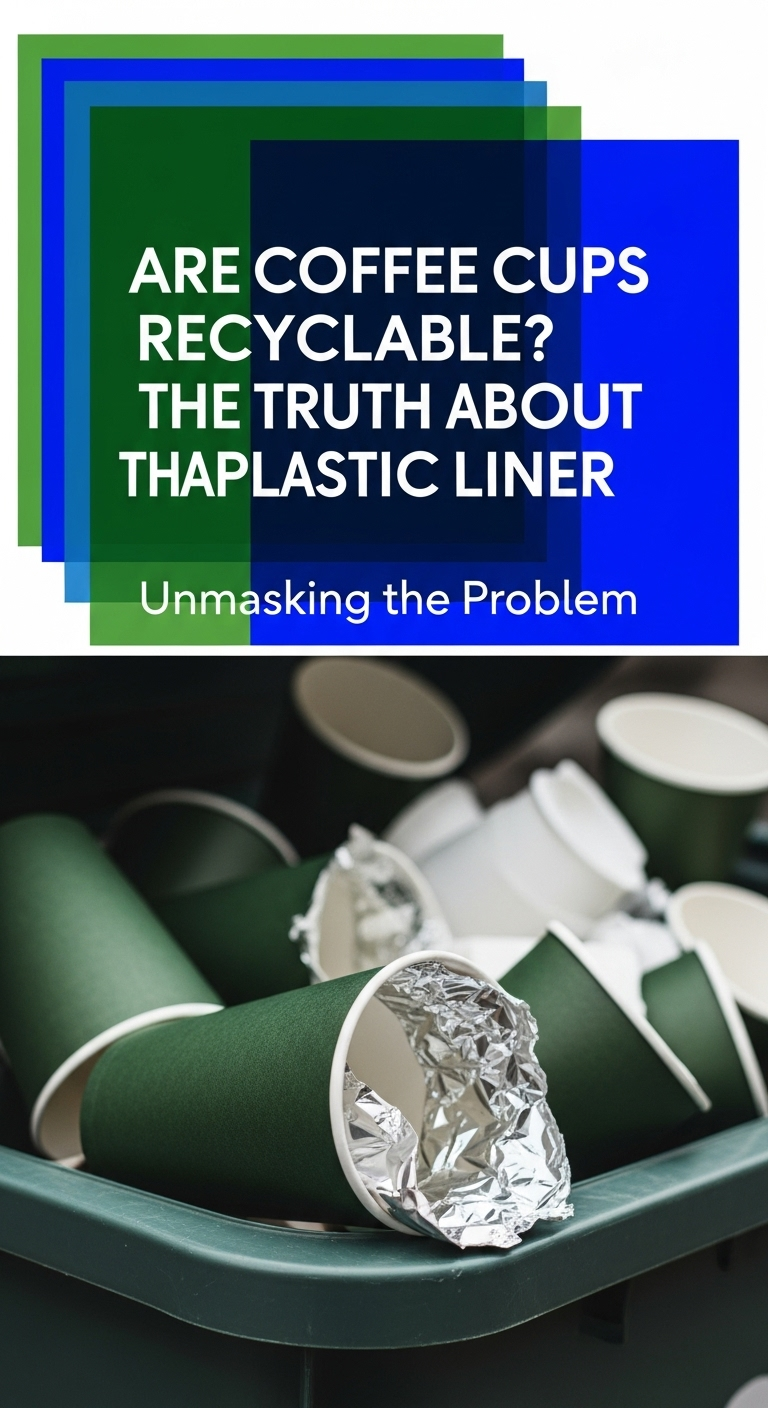As an Amazon Associate CoffeeXplore.com earns from qualifying purchases.
Are Coffee Cups Recyclable? The Truth About That Plastic Liner
Ever stood over the recycling bin, coffee cup in hand, and felt a pang of uncertainty? You’re not alone. The simple act of disposing of a disposable coffee cup has become a moment of confusion for millions, clouded by conflicting information and wishful recycling. You want to do the right thing, but the question lingers: are single use coffee cups recyclable?
For the most part, standard single-use coffee cups are NOT recyclable in most curbside programs. The primary reason is a hidden plastic lining that contaminates the paper recycling process. This plastic layer, essential for holding hot liquid, makes the cup a mixed-material product that standard facilities cannot handle.
This guide, leveraging extensive analysis of recycling processes and material science data, will definitively unpack this complex issue. We will deconstruct the coffee cup to reveal its core problem, provide a clear, actionable guide to each of its components, and clarify the truth behind so-called “eco-friendly” alternatives. By the end, you’ll have the clarity to make the most sustainable choice every time you enjoy your coffee.
Key Facts
- Globally Low Recycling Rate: Well-established research indicates that globally, we recycle an estimated 1 to 3% of the billions of single-use coffee cups produced annually, with the vast majority ending up in landfills.
- The Liner is the Main Culprit: The waterproof inner coating, typically made from polyethylene (PE) plastic, is the primary reason for recycling failure. It does not separate from the paper fibers in standard paper mills.
- “Compostable” Is Not a Magic Bullet: Compostable cups require specialized, high-heat industrial composting facilities to break down properly. They contaminate the paper recycling stream and will not decompose in a landfill or backyard compost pile.
- Specialized Facilities Are Rare: While the technology to recycle these cups exists, it is not widespread. As of recent data from 2020, only about 40 specialized facilities in all of North America were equipped to handle them.
- Contamination Kills Recycling Efforts: Any leftover liquid or food residue in a cup can contaminate an entire batch of otherwise good recyclables, rendering them useless and destined for the landfill.
The Big Question: Are Single-Use Coffee Cups Recyclable?
For the most part, standard single-use coffee cups are NOT recyclable in most curbside programs. The primary reason is a hidden plastic lining that contaminates the paper recycling process. While the cup feels like paper, this thin, fused-on plastic layer makes it a composite material that standard paper recycling facilities, known as paper mills, are simply not designed to handle.

This leads to a staggering environmental reality. The vast majority of the billions of disposable cups we use each year are not recycled. Instead, they take a one-way trip to the landfill.
Evidence from numerous environmental studies and waste management reports shows that because of their composite nature and the lack of widespread specialized recycling infrastructure, over 99% of single-use coffee cups end up in landfills or incineration facilities.
This is the central paradox of the disposable cup: a product used for mere minutes is engineered in a way that creates a long-lasting waste problem. To truly understand why, we need to look inside the cup itself.
The Core Problem: Deconstructing the Disposable Coffee Cup
A typical hot coffee cup is a composite material, fusing paperboard with a waterproof plastic (polyethylene) or wax lining that paper mills are not equipped to separate. This multi-material construction is the fatal flaw that prevents it from being part of a simple, circular recycling system. It’s not just paper; it’s a hybrid product that fails in a system designed for pure materials.
Quick Fact: That thin, shiny layer inside your cup? It’s typically polyethylene (PE), a type of plastic that makes up about 5% of the cup but causes 100% of the recycling problem.
Let’s break down the layers that make up a standard disposable cup:
- Paperboard Substrate: This is the main body and structure of the cup. To withstand the rigors of holding hot liquid, it’s typically made from high-quality virgin wood fibers, not recycled paper.
- Inner Lining: This is the critical, waterproof barrier. In most modern cups, this is a coating of polyethylene (PE), a fossil-based plastic, fused to the paperboard with heat. Some older or specialty cups might use wax, while newer “eco” versions may use bioplastics like polylactic acid (PLA).
- Outer Coating: Some cups may have an additional coating on the outside for better printing quality or to provide a moisture barrier, further complicating the material mix.
Why the Plastic Liner Makes Recycling So Difficult
The plastic liner does not separate from the paper fibers during the pulping process, leading to contamination and equipment failure in standard paper recycling facilities. Think of it like trying to recycle a paper sheet that’s been permanently laminated; the two materials are bonded too tightly for conventional methods.
Analogy: Imagine trying to recycle a paper sheet that’s been laminated. That’s essentially what a coffee cup is to a paper mill.
Here’s a step-by-step look at why the process fails:
- Entry into the Paper Stream: A plastic-lined cup is sorted (often incorrectly by consumers) into the paper recycling bin.
- The Pulping Process: At the paper mill, paper products are mixed with water and chemicals in a giant vat called a pulper, which agitates the mixture to break it down into a fibrous slurry.
- The Failure Point: While regular paper and cardboard dissolve into pulp, the polyethylene plastic liner does not. It rips off the paperboard in large flakes.
- Contamination and Damage: These plastic flakes contaminate the entire batch of paper pulp, lowering its quality and value. Worse, they can clog filters, screens, and other expensive machinery at the mill, causing costly shutdowns and operational headaches. This is why most mills reject bales of paper that contain coffee cups.
A Component-by-Component Guide to Your To-Go Coffee
While the cup itself is rarely recyclable, the cardboard sleeve is almost always recyclable, and the plastic lid often is, depending on local rules. The key to minimizing waste is to treat your to-go coffee not as one item, but as three or four separate pieces, each with its own disposal path.
Pro Tip: The easiest win? Always slip off and recycle the cardboard sleeve. It’s almost universally accepted.
Before tossing anything, you must check the guidelines for your local municipal recycling program. Acceptance of plastics, in particular, varies dramatically from one city to another. Here is a general guide to help you sort correctly:
| Component | Material | Recyclability Status | Action Required |
|---|---|---|---|
| Paper Cup | Paperboard + PE Liner | Generally No in curbside bins | Must go to a specialized facility (rare). Otherwise, trash. |
| Plastic Lid | #5 (Polypropylene) or #6 (Polystyrene) | Often Yes (but check local rules) | Rinse clean. Avoid black plastic, as it’s hard for sorting sensors to see. |
| Cardboard Sleeve | Paper / Cardboard | Almost Always Yes | Remove from cup and recycle with paper and cardboard. |
| Clear Cold Cup | #1 (PET) or #5 (PP) | Frequently Yes (but check local rules) | Must be empty and rinsed clean of any residue. |
What About “Compostable” or “Eco-Friendly” Cups?
Compostable coffee cups are NOT recyclable and require specialized commercial composting facilities to break down; they will not decompose properly in a landfill or backyard compost. While they sound like a perfect solution, these cups come with their own strict set of rules that are often misunderstood by consumers.
Think ‘compostable’ means you can toss it in your garden? Think again. Here’s what it really means.
These “green” alternatives are a significant point of confusion. Putting a compostable cup in the recycling bin is a form of contamination, just like a plastic-lined cup. Here’s a breakdown of the common types:
- PLA-Lined Cups: These use Polylactic Acid (PLA), a bioplastic typically derived from corn starch, as the liner. They look and feel just like plastic-lined cups but are designed to be composted.
- Aqueous Coated Cups: These use a water-based dispersion coating as a barrier. Some newer versions are designed to be more easily repulpable in certain recycling systems, representing a promising innovation, but they are not yet the standard.
- BPI Certified: This is a key designation to look for. The Biodegradable Products Institute (BPI) certifies that a product will break down safely in a commercial composting facility within a specific timeframe.
Crucial Caveat: The term “compostable” is only meaningful if you have access to a commercial or industrial composting facility that accepts them. These facilities operate at high, sustained temperatures that are impossible to replicate in a backyard compost bin. Thrown in a landfill, these cups are deprived of oxygen and may not break down at all, or may release methane, a potent greenhouse gas.
The Best Solution: Shifting from Single-Use to Reusable
The single most effective way to combat coffee cup waste is to avoid it altogether by consistently using a reusable coffee cup. After dissecting the complexities and failures of single-use recycling and composting, the conclusion is clear: the only guaranteed solution is to remove the disposable cup from the equation entirely.
This isn’t just about reducing waste; it’s about fundamentally changing our relationship with convenience. The habit of grabbing a disposable cup is deeply ingrained, but the environmental cost is undeniable. Making the switch to a reusable mug is a powerful, direct action that sidesteps the entire recycling dilemma.
Consider this: one reusable cup can prevent hundreds of single-use cups from ending up in a landfill each year. What’s stopping you from making the switch?
The benefits are immediate and impactful:
- Zero Waste: You contribute no cups to the landfill or the flawed recycling system.
- Reduced Carbon Footprint: You eliminate the 0.24 lbs of C02 emissions associated with the production and transport of each single-use cup.
- Financial Savings: Many coffee shops, as noted in industry reports, offer a small discount to customers who bring their own mugs, which adds up over time.
- Better Experience: Coffee simply tastes better from a ceramic or stainless steel mug than from a paper and plastic cup.
For those ready to make the change, finding a high-quality reusable mug is the perfect first step. A well-insulated, leak-proof travel cup can make the transition from disposable to sustainable both easy and enjoyable.
FAQs About Single-Use Coffee Cup Recycling
Why can’t you just recycle the paper part of the cup?
The plastic liner is bonded so tightly to the paper fibers that standard recycling equipment cannot separate them, leading to contamination. The paper mill’s pulping process is designed to dissolve pure paper. The fused plastic layer doesn’t dissolve; it just breaks into small pieces that ruin the batch of paper pulp and can damage the machinery.
Are plastic Solo cups or cold beverage cups recyclable?
Clear plastic cold cups (often #1 or #5 plastic) are more likely to be recyclable than paper hot cups. However, red Solo cups are made of polystyrene (#6 plastic), which is very difficult to recycle and not accepted in most programs.
* Clear Cold Cups: Typically made from #1 PET or #5 PP plastic, which are more widely accepted. Always rinse them clean and check local guidelines.
* Red Solo-style Cups: These are #6 Polystyrene, a brittle and lightweight plastic that has very low market value for recycling, so most facilities reject it.
What does it mean if a cup is “compostable”?
A “compostable” cup is designed to break down into organic matter, but only under the specific high-heat conditions of an industrial or commercial composting facility, not in your recycling bin or landfill. If you don’t have access to one of these specialized facilities, a compostable cup should be treated as trash. It contaminates the recycling stream.
Do I need to rinse my cup before trying to recycle any part of it?
Yes. Any food or liquid residue can contaminate an entire batch of recyclables, rendering them unusable. All items, including lids or plastic cups, must be empty and clean. Leftover coffee, milk, and sugar create mold and attract pests at recycling facilities, and the liquid can ruin paper and cardboard products in the same bin.
Are there any special programs for recycling coffee cups?
Yes, but they are limited. Specialized facilities and industry initiatives exist, but are not widespread, meaning most people do not have access to them.
* Specialized Mills: A small number of paper mills have invested in technology to separate the plastic liner, but these are not common.
* Industry Initiatives: Groups like the Paper Cup Recovery & Recycling Group (PCRRG) and programs like the NextGen Cup Challenge are working to innovate cup design and expand collection infrastructure, but these are long-term solutions, not widely available to the public today.
Final Summary: Your Role in Solving the Coffee Cup Problem
The truth about single-use coffee cups is unfortunately simple: their design is fundamentally at odds with our current recycling systems. The plastic liner that makes them functional also makes them waste. While “compostable” and “eco-friendly” alternatives seem promising, they present their own set of challenges and require infrastructure that is not yet widely available. The answer to are single use coffee cups recyclable is a clear but complicated “mostly no.”
Your power as a consumer lies in sidestepping this broken system. By understanding the problem, you can now make informed choices that have a real impact.
Here are your most powerful actions:
- Choose to Reuse: The single best action is to adopt a reusable coffee mug. This is the only way to guarantee you create zero cup waste.
- Dissect and Sort: If you must use a disposable cup, deconstruct it. Recycle the clean cardboard sleeve. Check if your local program accepts the clean plastic lid. The cup itself almost always goes in the trash.
- Reject “Wish-cycling”: Never toss a paper coffee cup (recyclable or compostable) into the recycling bin “hoping” it gets recycled. This act contaminates the system and creates more problems than it solves.
Start your new, waste-free coffee habit tomorrow. Choose your favorite reusable mug and make your daily coffee a vote for a healthier planet.
Last update on 2025-12-05 / Affiliate links / Images from Amazon Product Advertising API

